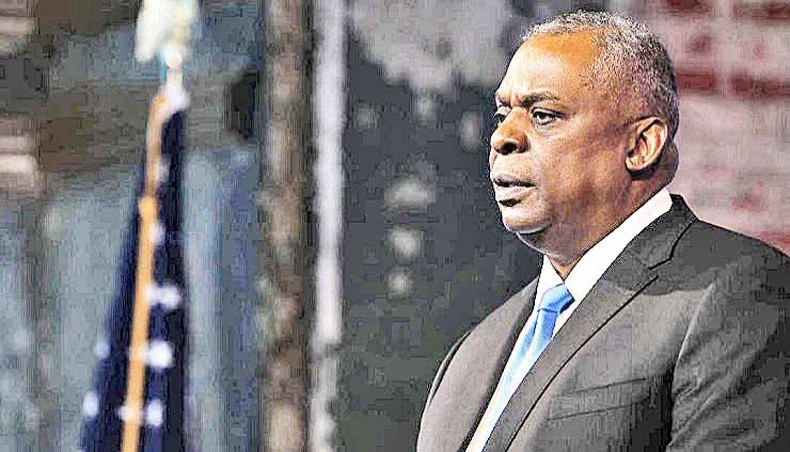How Washington turns the Pacific into a theatre
IN APRIL, at a press conference in Poland, the US secretary of defence Austin Lloyd openly declared that the core US objective in the Russia-Ukraine conflict was/is to weaken Russia militarily in ways to make its recovery difficult if not impossible for a long time. Austin said, ‘we want to see Russia weakened to the degree that it can’t do the kinds of things that it has done in invading Ukraine,’ adding that Russia ‘should not have the capability to very quickly reproduce’ the forces and equipment that had been lost in Ukraine. The statement was made in the wake of Ukraine, but the theatre of conflict, or the geographical extent of the anti-Russian axis, is not limited to Europe. The US is actively militarising the Pacific region — especially, Japan — to spread and strengthen its position. Last month, Japan announced its decision to double its military spending, increasing it from 1 per cent of its GDP to 2 per cent. This increase will allow Japan — a country constitutionally committed to an ideology of ‘pacifism’ and no active military force — to spend $86 billion on its defence.
Japan’s drive to arm itself has an interesting parallel in Europe, where Germany, too, has decided to massively increase its total defence spending to 100 billion euros. With Washington actively supporting these critical changes to establish powerful militaries around its core rival states — Russia and China in Europe and Asia — new forms of conflict are likely to emerge, with prospects of major counter alliances on the horizon too.
This is most evident from the latest (May 24) joint patrol of Russian and Chinese strategic bombers over the Sea of Japan and the East China Sea — an exercise that came as a response to Japan’s increasing drive, with an eye on Russia and China, towards militarism. It was, therefore, not surprising when Japan’s Liberal Democratic Party said that the April decision to increase the budget was prompted by the conflict in Ukraine and regional pressure from China. Even though Russia and China have posed no direct territorial threat to Japan, the latter’s decision to change its defence trajectory means that the Pacific region has begun to change in ways that would make conflict, or at least heightened tensions, inevitable, consequently dimming prospects of cooperation.
Japan’s increasing defence budget comes on top of the full possibility of ‘interoperability’ between the US and Japanese units, allowing the latter to ‘practice its forward-deployed attack capabilities.’ What is extremely important to note here is that the core purpose of the ‘interoperability’ is not defensive; it is offensive, which means that Japan’s so-called ‘pacifism’ is nothing more than a rhetoric that Tokyo uses — and will continue to use — to mask its rapidly growing military preparedness against Russia and China.
That this process is being actively supported by the US is evident from the Japanese prime minister Fumio Kishida’s announcement, on the sidelines of Biden’s Tokyo visit, to ‘drastically strengthen’ its military capabilities.
According to a new economic policy draft released by the Kishida administration, the decision is a response to ‘attempts to unilaterally change the status quo by forces in East Asia, making regional security increasingly severe.’ If this assessment sounds vague, it is by design to camouflage Japan’s rise as a new military power that can rival Russia and China as a US ally.
In fact, it is already acting as a US ally against Russia in the Russia-Ukraine conflict. In April, Japanese officials announced that they will send defence equipment — drones and protective gear — to Ukraine to help the Ukrainian military fight the Russian forces. While Japan’s Self-Defence Forces rules prohibit the transfer of defence products to other countries, defence minister Nobuo Kishi justified this transfer as ‘commercial’ and ‘disused items.’ More self-serving justifications will be invented to mask Japan’s so-called ‘pacifist militarisation.’
Further tensions with Russia are likely to follow. In April, around the same time Tokyo announced increasing its budget, the Japanese government also shifted its stance on the Kuril islands.
In its 2022 Diplomatic Bluebook, Japan said that ‘The Northern Territories are a group of islands Japan has sovereignty over and an integral part of Japan’s territory, but currently they are illegally occupied by Russia.’
This description is a major diplomatic shift insofar as it raises the level of tensions surrounding what was previously disputed territory. Calling Russia an ‘illegal’ occupier shows Japan just subscribing to the western narrative about the Russian ‘occupation’ of Crimea.
In practical terms, by raising the temperature against Russia (and China as well), Japan is transforming itself into a front-line military ally of the US and NATO in this part of the world.
Japan’s militarisation under the shadow of US support is also tied to how the US/west is increasingly projecting NATO not as a regional alliance; in fact, recent developments have shown how NATO is arrogating to itself a ‘global’ role. In April, the UK’s foreign minister Liz Truss called for a ‘global NATO.’ She added that NATO must have a ‘global outlook’ to be able ‘to pre-empt threats in the Indo-Pacific, working with our allies like Japan and Australia to ensure the Pacific is protected. And we must ensure that democracies like Taiwan are able to defend themselves.’
Japan is, thus, by default a logical extension of NATO’s global ie, anti-Russia and anti-China, geo-politics. Tokyo’s decision to re-arm itself to acquire offensive capability is, thus, not tied to its own needs but to the ways the US is manufacturing a global anti-Russia and anti-China coalition to defeat them and sustain its own global hegemony.
New Eastern Outlook, June 9. Salman Rafi Sheikh is a research-analyst of international relations and Pakistan’s foreign and domestic affairs.
News Courtesy:
https://www.newagebd.net/article/172907/how-washington-turns-the-pacific-into-a-theatre











